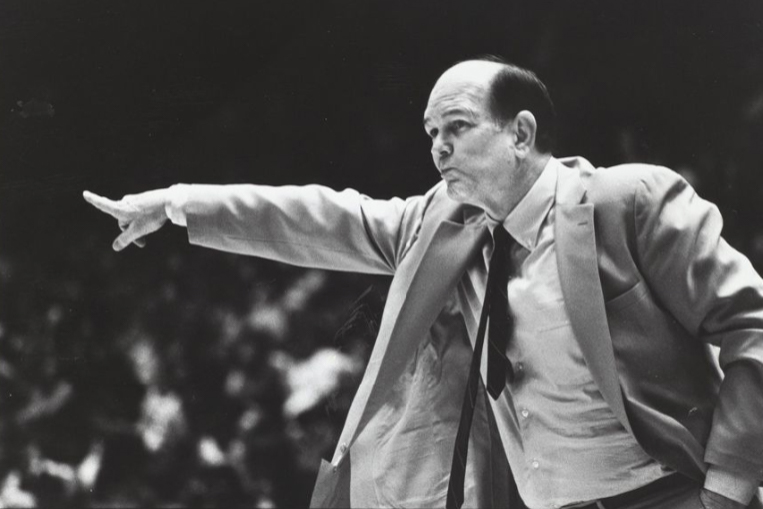Gary Williams knows the state Maryland men’s basketball was in when his playing career ended in 1967. He also knows what the program looked like when he became the Terps’ head coach in 1989. There wasn’t much similarity.
Lefty Driesell — who coached Maryland for 17 of the 22 seasons in between — was responsible for that transformation. He elevated the Terps from a bottom-feeder to a nationally relevant program.
Driesell died Saturday morning at the age of 92. Williams and several of Driesell’s former players reflected on the fiery coach’s legacy during Maryland’s game against Illinois later that day.
Williams remembers the environment Driesell fostered in Cole Field House as the program ascended in prominence and strength. Driesell not only powered Maryland forward, but did it boldly.
“That takes some guts to do that,” Williams said. “Obviously, Lefty had that ability.”
Williams admired Driesell’s fearlessness. That trait was evident when Driesell proclaimed Maryland could become “the UCLA of the East” at the beginning of his tenure with the Terps. His fearlessness, southern drawl and iconic V for victory symbol are Driesell’s defining traits for those who rooted for his squads.
For the program to reach the heights Driesell wanted, Maryland would have to beat the country’s premier programs. Driesell’s desire to overcome former ACC foes such as Duke and North Carolina stood out to Terry Long, who played at Maryland under Driesell from 1983 to 1986.
“I think they beat us more than we beat them, but when we beat them, man, coach was happy as a kid in Disneyland,” Long said.
Multiple players described Driesell as loving behind his tough, competitive exterior.
[Legendary Maryland men’s basketball coach Lefty Driesell dies at 92]
Keith Gatlin was a leader on Driesell’s team that beat No. 1 North Carolina on the road in 1986. But that moment wasn’t what Gatlin treasured most about his time playing for Driesell.
“The best times I had with him actually was at his house,” Gatlin said. “On Saturdays, we would play one-on-one, go to church with him and his family on Sunday. Those are things that I don’t think coach got a lot of credit for. He was way before his time. With these kids, now you have to connect before you can correct, and he really connected with us.”
The coach’s ability to connect with players may have benefitted him most in recruiting.
Maryland wasn’t Jeff Baxter’s first choice when he was a high schooler, but that changed when Driesell made a recruiting visit to him and his family.
“As soon as he left, I said, ‘Mom, I think I’m going to Maryland,’” Baxter said. “She said, ‘really?’ I said, ‘Yeah.’ She said, ‘But he’s got such a southern drawl,’ and I’m from Washington, D.C. I said, ‘I know, but there’s something about him I really like.’”
Driesell and current Maryland coach Kevin Willard only spoke four or five times during Willard’s two years at the helm in College Park, he said after Saturday’s game.
Willard said Driesell’s love for Maryland was clear in those few conversations, in which the former coach consistently brought up his 348-159 record. Driesell boasts the second-most wins in program history behind Williams.
Driesell reached two Elite Eights and won the NIT in 1972 — a tournament that was much more prominent at the time. Driesell was named ACC coach of the year twice in an era dominated by North Carolina’s Dean Smith and the rise of Duke’s Mike Krzyzewski.
[Pandemonium: Maryland men’s basketball’s 31-30 upset over South Carolina, 50 years later]
“He established a standard here at the University of Maryland,” Williams said. “Even though we had some things that weren’t right when I got here, we were able to get it back on a national level, and I think it’s easier when it’s already been done to repeat it.”
Though Driesell didn’t have an NCAA championship team of his own, Williams’ national tournament success might not have been possible without Driesell building the program.
Driesell’s own squads weren’t too shabby, either. His 1974 team, led by Len Elmore, John Lucas and Tom McMillen, finished the season ranked No. 4 in the AP poll. According to Krzyzewski, the group was underrated.
“Lefty’s team that year,” Krzyzewski told The Athletic in 2018, “was probably as good as 20 national champions.”
Driesell’s tenure at Maryland ended in 1986 after Len Bias died of a cocaine overdose. The school reassigned Driesell into an administrative role in October 1986, and he took the head coaching job at James Madison in 1988.
“The scenario with my teammate, Len Bias, was totally unfortunate. But also it was totally out of his realm … Coach could not monitor or watch everything we did,” Baxter said. “Some people said he was the scapegoat. In any scenario where you’re the leader of any team, any organization, something happens, you’re going to take that fall.”
Many feel that the Bias incident is what led to Driesell’s Naismith Memorial Basketball Hall of Fame induction only coming in 2018, 15 years after he retired. Williams and Driesell’s players felt it was well-deserved.
Driesell was “a character,” Williams said. He would have to clean up most of his favorite stories about the colorful, ambitious coach to share them, he added.
“When they write the ultimate book on basketball, he’s gonna have a couple of chapters,” Williams said.



